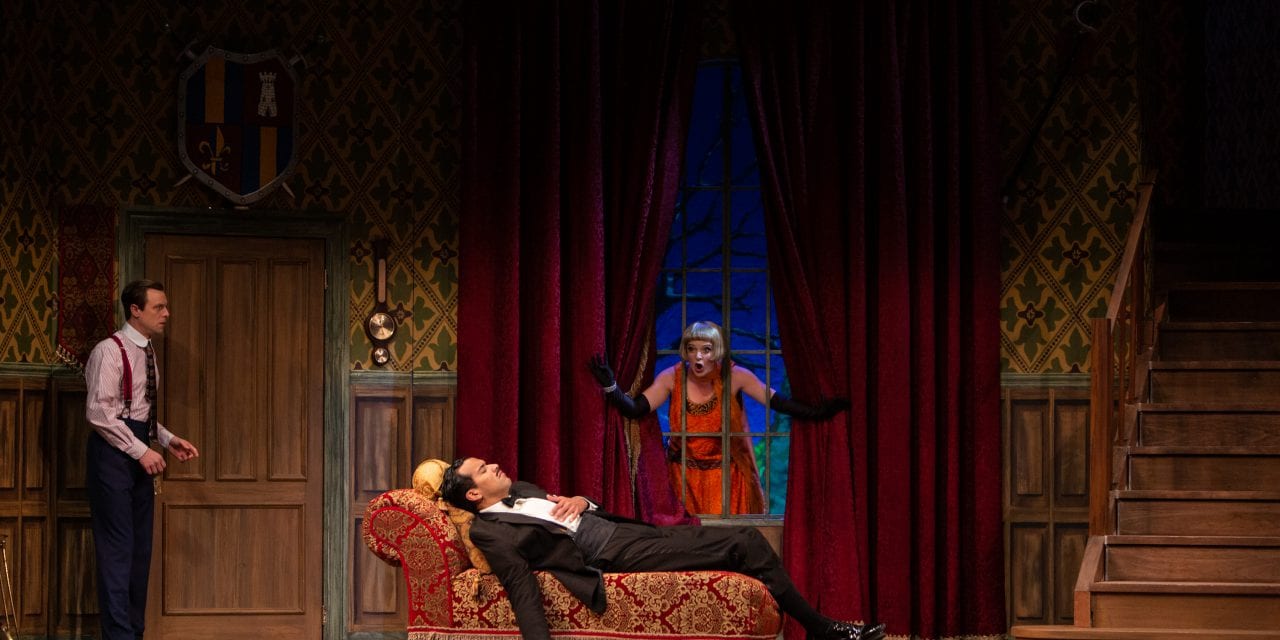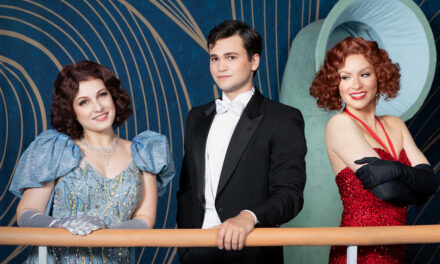SALT LAKE CITY — I’ve never seen an audience laugh more than at the performance of, The Play that Goes Wrong, in Pioneer Theatre. The 2015 British concoction has bounded across the world since its creation (picking up a Tony for set design along the way) and lives up to all the hype. Written by Henry Lewis, Henry Shields, and Jonathan Sayer, it’s one of the silliest, funniest things ever put to stage.

Show closes December 21, 2019.
The less you know about the play the better, so I recommend you stop reading now and buy your ticket immediately.
Still here? Well, the play revolves around a backwater British technical college’s theater department that happens to be quite terrible at putting on plays. Their current offering is a clichéd murder mystery called, The Murder at Haversham Manor. Everything that could possibly go wrong during the course of the production does. Be prepared for the fourth wall to be immediately ejected as soon as you walk in the door. The evening might include ticket issues, being conscripted to find lost cast members, and constructing the set.
There’s a reason that this fairly new show has been translated into 21 languages: it’s just plain hilarious. Its foundation is the universal language of physical comedy. Given the time frame of the play within a play, it immediately calls to mind the Three Stooges and Chaplin and Keaton, although it could claim Weekend at Bernie’s as inspiration as well. While slapstick might not be everyone’s cup of tea theoretically speaking, it would take a curmudgeon of epic proportions not to laugh at the endless inventive goofiness of The Play that Goes Wrong.
But physical humor isn’t the only source of comedy. Theater lovers in particular will enjoy seeing familiar acting quirks and technical goofs magnified to extraordinary levels. Pretty much every thing and person onstage (and backstage) gets mishandled and mangled during the course of the evening, which culminates in a sword fight with no swords but plenty of mouthed sound effects.

William Connell as Chris Bean/Inspector Carter. Photo by Pioneer Theatre Company.
The cast is hilariously (and for a reviewer, almost maliciously) misidentified in the program. As far as I can tell, William Connell portrays the play’s director, Chris, and the Inspector. Connell’s opening monologue got the evening off to a wonderful start as his character introduced the audience to the topsy-turvy world that is the Cornley Polytechnic Drama Society. I’m still smiling at the impeccable comedic delivery of his unforgettable line, “James, where’s your peach?”
All the leads have about equal roles, although Greg Balla plays the leading man of the play within a play. Balla was appropriately dashing and upper-crust as the British aristocrat, and he earned abundant laughs for his physical comedy. Easily the star of body comedy in his show, Brandon Contreras slayed as Jonathan Harris/Charles Haversham. Contreras’s movements as a corpse had the me roaring just minutes into the show, and the way his character’s guilty cheeks fluttered after his “resurrection” was a moment of pure theatrical delight.
Any 20th century murder manor needs a seductress, and this one’s was played by Ruth Pferdehirt as Sandra Wilkinson/Florence Colleymoore. And what would a British manor be without a dutiful butler? Eric Santagata was a brilliant Perkins/Dennis Tyde and remained crisply in character despite the madness happening around him. Other leads included Jordan Sobel as Cecil Haversham/Arthur the Gardener and Kristen Wyatt as Annie Twilloil, a poor stage hand who gets pulled into the madness and performs her entire role on book to limited success.
The play is delivered in British accents, and the cast deserves credit for never letting the accents get in the way of the fun. To this American’s ears, the accents were hunky dory. The actors are all equity except for a few University of Utah students who play the technical crew. The entire cast’s ability to stay in character during all the mayhem was remarkable. How the leads were able to do the grandfather clock scene with a straight face is a modern marvel. I won’t spoil it, but if you’ve seen the play, you know exactly what I’m talking about.
Karen Azenberg directed the complex show marvelously, allowing the humor of the actors and the humor in the props and set design to shine through. Sets (by James Kronzer) and props were a technical marvel, requiring no less than four stage managers and assistants to wrangle (Mary P. Costello, Becky Lynn Dawson, Emily Nacrissa Griffith, Emma Elzinga). The entire crew deserves a standing ovation for the dizzying amount of tech they had to pull off.
The play is appropriate for most audiences and would probably be rated PG or PG-13 if it was a movie. It features a large amount of biblical swears, religious based profanity, cartoonish violence, and a couple instances of accidental, clothed sexual contact.
I was worried going into this show that the humor might be too British for a mass audience. That worry couldn’t have been further from the truth. The Play that Goes Wrong is hilarity for all ages and the best ticket in town. Don’t miss it.

This review generously sponsored by a grant from the Salt Lake County Zoo, Arts, and Parks program.




